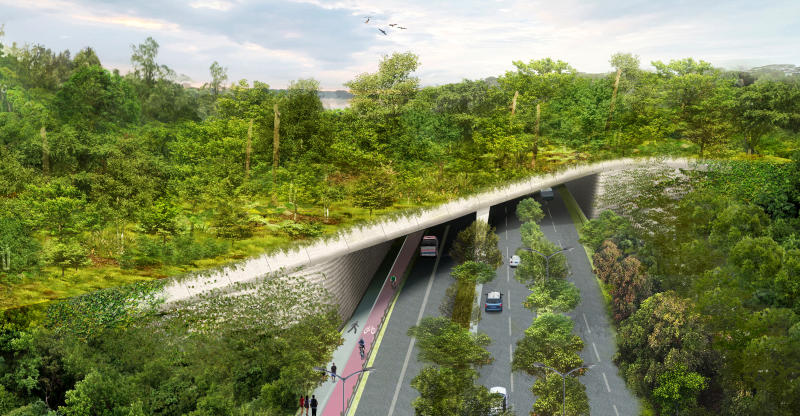Mandai Eco-Link: All you need to know about the wildlife bridge
Sign up now: Get ST's newsletters delivered to your inbox

An artist’s impression of the new Eco-Link bridge over Mandai Lake Road.
PHOTO: MANDAI PARK HOLDINGS
Follow topic:
SINGAPORE - Native animals living in the forests of Mandai will be able to use an overhead bridge of their own by the end of 2019.
The bridge is among efforts by Mandai Park Holdings (MPH) - which is developing a nature precinct of five wildlife parks in the area - to minimise the impact on wildlife as the hub is being built.
The hub is expected to be ready by 2023. It will contain a new rainforest park and the bird park, which will be relocated from Jurong, and will be built on two plots in the area.
The two plots are on state-owned land, but are now overrun by regenerated secondary forests. The plots are located just outside the Central Catchment Nature Reserve, and are part a rich ecological vein of flora and fauna in the area.
MPH provided details of the bridge at a briefing on Thursday (July 26).
The elevated wildlife crossing, which will not be open to members of the public, will be 44m wide and span the length of Mandai Lake Road. It will provide a safe passage for animals crossing between parts of the Central Catchment Nature Reserve, which straddles both sides of the road.
For years, there have been reports of animals - such as the critically endangered Sunda pangolin - crossing Mandai Lake Road and getting run over by cars.
The Mandai Eco-Link will be similar to an existing wildlife crossing - built by National Parks Board (NParks) - that runs across the Bukit Timah Expressway (BKE).
Here are some interesting facts about the Mandai Eco-Link:
1. Wildlife bridges: How do they work?
The bridges help animals safely get from one part of the forest to another, across roads and expressways.
For instance, the 62m-long Eco-Link@BKE, which opened in 2013, connects the Bukit Timah and Central Catchment nature reserves. When the BKE was built in 1986, it cut a line through the reserve area, splitting it into two.
The Mandai Eco-Link will link the central and northern swathes of the Central Catchment Nature Reserve that are now separated by Mandai Lake Road.
The ability to move between one forest area to another is important for animals, especially in Singapore. This is because the island's nature areas are fragmented by urban development, unlike in countries that have rolling acres of forests.
Being able to move from forest to forest will help animals feed and breed without becoming isolated.
2. Will animals use the bridge?
Animals cannot be forced to use the bridge. However, ecological studies suggest that there are several ways to encourage them to use wildlife crossings.
- Using native plants on the bridge will be a key strategy.
Native plants found in Singapore's forests provide food and shelter for animals in the wild. Ensuring that they can be found on the bridge will make sure there is an unbroken landscape of vegetation the animals are familiar with.
Tree species being used on the Eco-Link@Mandai include Archidendron jiringa, Sterculia parviflora, Shorea leprosula and Ilex cymosa, MPH said. The saplings will be transplanted from other parts of the forested area that is being developed, or bought.
- Ensuring that there are suitable "layers" of vegetation
In natural forests, there are several such layers - the understorey, which refers to vegetation near the floor, the midstorey, and the top-most layer, the canopy.
Different animals use the different layers to find food and shelter. Nectar bushes and shrubs, for instance, are frequently patronised by butterflies. Some insects live on the forest floor, as do land-dwelling mammals such as the pangolin and mouse deer.

Birds like the greater racket-tailed drongo and straw-headed bulbul tend to find food in the mid-storey.
There are also arboreal animals that are found in the forest canopies. These include the Malayan colugo, which glides from tree to tree.
- Making sure animals can find their way to the bridge
These strategies will not work if animals cannot locate the bridge in the first place.
That is why biodiversity surveys and data on road kill hot spots, for example, are important.
For the Eco-Link@BKE, NParks conducted studies on the types of biodiversity that can be found on both sides of the bridge by, for instance, setting up camera traps. There are ongoing studies monitoring the wildlife in the area.
Efforts to monitor animals on both sides of the Mandai Eco-Link started in November 2016, and include camera trapping surveys and transect surveys.
In transect surveys, scientists record the wildlife they find on walks along a specific route in the forest. MPH said such efforts will continue during the construction of the Eco-Link.
An MPH spokesman said: "After the completion of the Eco-Link, the monitoring programme will be extended to the bridge itself, to understand wildlife utilisation of the bridge."
3. Which animals are likely to use the bridge?

- The Sunda pangolin, which is critically endangered in Singapore.
There have been reports of pangolins ending up as roadkill in Mandai Lake Road.
- Lesser mouse deer, another endangered mammal in Singapore.
It is 45cm long, 20cm tall at the shoulders, and weighs just 2kg. It is the smallest of all hoofed mammals anywhere in the world. It is unclear if these shy animals will use the bridge, as they usually dwell deep in the forest interior.

- Straw-headed bulbul, a bird widely hunted in South-east Asia for its melodious song.
It is listed as endangered in the International Union for Conservation of Nature Red List. In December 2016, a Straits Times report said Singapore is thought to have at least 200 straw-headed bulbuls. Non-governmental organisation Traffic, which monitors the wildlife trade, said Singapore was "one of the few remaining strongholds for the species".

